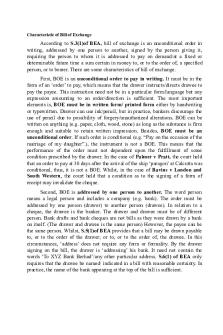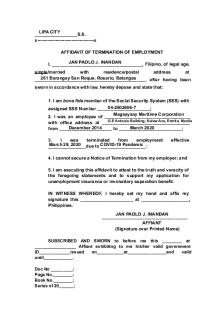Developement OF Occlussion PDF

| Title | Developement OF Occlussion |
|---|---|
| Author | Dhanyasree B.M |
| Course | BDS |
| Institution | Kerala University of Health Sciences |
| Pages | 20 |
| File Size | 1.3 MB |
| File Type | |
| Total Downloads | 77 |
| Total Views | 116 |
Summary
development of occlusion is genetically and environmentally conditioned process which shows great deal of individual variants...
Description
DEVELOPMENT OF OCCLUSION INTRODUCTION •
Development of occlusion is a genetically and environmentally conditioned process which shows a great deal of individual variants.
•
The latin word “occlusion” defines as the relationship between all the components of the masticator system in normal function, dysfunction and parafunction.
STAGES OF OCCLUSAL DEVELOPMENT 1. Predentate jaw relationship 2. Deciduous dentition period 3. Mixed dentition period 4. Permanent dentition period
PREDENTATE DENTITION •
Period soon after birth.
•
Neonates has no teeth, but gum pads are of equal importance.
•
Gum pads
Fig. 1 Gum pads o
Alveolar process at the time of birth.
o
Pink, firm and covered by dense periosteum.
o
Horseshoe shaped.
o
Divided into 2 parts by dental groove 1. Labiobuccal 2. Lingual
o
Divided into 10 segments by transverse groove. 1
o
Lateral sulcus- transverse groove between canine and first molar.
o
Gingival groove seperates gum pads from the palate.
o
Wider maxillary gum pads produce anterior openbite helps in suckling.
Fig. 2 Anterior open the relation between upper and lower gum pads at birth
DECIDOUS DENTITION PERIOD Characteristic features •
Spaced dentition
•
Slight overjet
•
Shape of dental arches half round or ovoid
•
Shallow cuspal interdigitation
•
Vertical inclination of incisors
•
Deep bite
•
Different maxillo mandibular relations like flush,mesial &distal terminal planes.
•
Almost no curve of spee present .
•
Spacing o
Delabarre – first describe interdental spacing in primary dentition.
o
Bauma – divided primary dentition into 2: 1. Spaced dentition: Primate space and Physiologic space
Primate space (simian space/arthropoid space) - Exist between maxillary lateral incisor and canines and mandibular canines and first deciduous molar.
2
Fig. 3 A and B Primate space
Physiologic space - Present in between all the primary teeth. Maxilla: 0-8 mm (average 4mm) Mandible: 1-7mm (average -3mm)
Fig. 4 Physiologic spaced 3
2. Non spaced dentition
Fig. 5 Non spaced dentition
TERMINAL PLANES •
Mesiodistal relation between the distal surface of maxillary and mandibular second deciduous molars.
•
It is of 3 types:
1. Flush terminal plane
Fig. 6 A and B Flush terminal plane
4
2. Mesial terminal plane
Fig. 7 A and B Mesial terminal plane
3. Distal terminal plane
Fig. 8 A and B Distal terminal plane
Flush terminal plane •
The distal surface of deciduous second maxillary and mandibular molars are in same vertical plane.
•
Most favourable to class I molar relation in permanent dentition Seen in 74%.
Mesial terminal plane •
The distal surface of decidous second mandibular molar is more mesial to that of decidous second maxillary molar. 5
•
Guides permanent molar to class I relationship.
•
Seen in 14%.
Distal terminal plane •
Distal surface of decidous second mansibular molar is more distal to that of decidous second maxillary molar. o
Seen in 10%.
ANTERIOR TEETH RELATIONSHIP •
Overbite o
It is the distance, which the incisal edge of the maxillary incisor overlaps vertically past the incisal edge of mandibular incisors.
o
Average overbite in primary dentition is 2mm.
Fig. 9 Overbite •
Edge to edge o
When incisal edge of 2 incisors is in same plane.
o
Also called zero overbite.
Fig. 10 Edge to edge
6
•
Overjet o
Horizontal distance between lingual aspect of maxillary incisors and labial aspect of mandibular incisor when teeth are in centric occlusion.
o
Average 1-2mm.
Fig. 11 Overjet •
Canine relationship o
Most stable relationship in primary dentition.
1. Class I o
Mandibular canine interdigitates in embrasure between the maxillary lateral incisor and canine.
Fig. 12 Class I canine relation 7
2. Class II o
The mandibular canine interdigitates distal to embrasure between maxillary lateral incisor and canine.
Fig. 13 Class II canine relation
3. Class III o
Mandibular canine interdigitates in any other relation.
Fig.14 Class III canine relation
8
MIXED DENTITION PERIOD •
The period during which both the primary and permanent teeth are present in the mouth together is known as mixed dentition.
I. First transitional period •
Characterised by: a) Emergence of 1st permanent molars. b) Exchange of decidous incisors with permanent incisors.
(a) Emergence of first permanent molar o
Mandibular molars are the first to erupt at around 6years of age.
o
Position and relation of permanent molars is depent on the relation of 2nd decidous molars.
o
If 2nd molar is in flush terminal plane, then erupting permanent molar will also be in the same relation.
o
It is accomplished by,
1. Early mesial shift o
Eruptive forces of 1st permanent molars push the decidous molars forward & utilizing the primate space and establishing class I relationship.
Fig. 15 Early mesial shift
2. Late mesial shift o
In non-spaced dentition, the erupting permanent molars are unable to establish class I relation.
9
Fig. 16 Late mesial shift o
In this case, the molars establish class I by drifting mesially and utilizing leeway space after exfoliation of decidous molars.
o
If 2nd decidous molar is in mesial step terminal plane,then the erupting permanent molar will directly erupt in class I relation ,If further growth occurs Class III.
o
Decidous 2nd molar is in Distal step terminal plane, erupting permanent molarclass II relation, if further growth occurs lead to End on molar relation.
Fig. 17 Terminal plane prediction 10
(b) Exchange of incisors o
Decidous incisors are replaced by permanent incisors.
o
Period of transition from 6 ½ -8 ½ years.
o
The permanent incisors are larger as compared to their primary counterparts, and thus require more space for their alignment. This difference between space available & space required is Incisor liability.
o
7mm – maxillary arch
o
5mm- mandibular arch
Fig. 18 Exchange of incisors II. Intertransitional period •
Maxillary and mandibular arches consist of permanent incisors and permanent molars that sandwitch the decidous canines and molars.
•
Lasts for 1 1 /2 years.
III. Second transitional period •
Characterised by replacement of decidous molars and canines by premolars and permanent canines and eruption of maxillary lateral incisor and canines.
•
Occurs in around 9 -11 years of age.
•
Critical for the alignment of erupting permanent teeth.
(1) Replacement of decidous molars and canines o
The combined mesiodistal width of permanent canines and premolars is less than that of decidous canine and molars, this extra space is LEEWAY SPACE OF NANCE
o
Maxillary arch 1.8mm (0.9mm each side)
o
Mandibular arch 3.4mm (1.7mm each side)
11
o
The dimension of decidous 2nd molars is more than that of 2nd premolars, this excess space is called as E-SPCE.
Fig. 19 Leeway space of nance
Fig. 20 E-space (2) Eruption of maxillary canine o
Significant event in second transitional period
o
Self-correcting malocclusion is seen around 8-11 years of age, first described by Broadbent. 12
UGLY DUCKLING STAGE or Broadbent phenomenon o
As the permanent maxillary canine erupt, they displace the roots of lateral incisors mesially. This force transmitted to the central incisor and their roots are also displaced mesially. The resultant force causes the distal divergence of crown in the opposite direction, leading to midline spacing.
o
Ugly duckling stage corrects itself after the eruption of canines, since call it as a selfcorrecting anomaly.
Fig. 21 Broadbent phenomenon
Fig. 22 Clinical and radiographic appearance of ugly duckling stage
13
PERMANENT DENTITION •
Maxillary arch: 6-1-2-4-5-3-7-8
•
Mandibular arch: 6-1-2-3-4-5-7-8
•
Entire permanent dentition is formed within the jaw after birth except for the cusps of 1st molar, which is formed before birth.
•
Changes seen are: o
Horizontal overbite decreases.
o
Dental arches become shorter.
o
Vertical overbite decreases by 0.5mm.
o
Overjet decreases by 0.7mm.
KEYS OF OCCLUSION Andrew’s 6 keys of occlusion o
Molar inter arch relationship
o
Mesiodistal crown angulation
o
Labiolingual crown inclination
o
Absence of rotation
o
Tight contacts
o
Curve of spee
o
Bolton’s discrepancy
1. Molar inter arch relationship o
Disal surface of the distobuccal cusp of upper 1st permanent molar made contact and occluded with the mesial surface of lower 2nd molar
o
The mesiodistal cusp of upper 1st permanent molar fell within the groove between the mesial and middle cusps of the lowr 1st permanent molar.
Fig. 23 Molar inter arch relationship 14
2. Mesiodistal crown angulation o
It is the angulation of long axis of the crown, not to angulation of long axis of entire tooth.
Fig. 24 A and B: Mesiodistal crown angulation
3. Crown inclination o
Labiolingual or bucco-lingual inclination of the long axis of the crown,not to the inclination of the long axis of the entire tooth
Fig. 23 Crown inclination
15
4. Absence of rotation o
Rotated teeth will occupy more space more space hence normal occlusion should be free from rotation.
Fig. 24 Absence of rotation
5. Tight contact o
Permanent dentition should have close contact to optimize space.
Fig. 25 Tight contacts
16
6. Curve of spee o
Occlusal plane should be flat with curve of spee not exceeding 1.5mm
Fig. 26 Curve of spee
Fig. 27 Different types of spee
17
SELF CORRECTING ANOMALIES •
Anomalies, which arise in the child’s developing dentition during the period of transition from predentate period to permanent dentition period and get corrected on their own without any dental treatment.
Stages of development
Self correcting anomalies a) Retrognathic mandible
Predentate period
b) Anterior openbite c) Infantile swallow a) Anterior deep bite
Decidous dentition
b) Primary spacing c) Flush terminal plane a) Mandibular anterior crowding
Mixed dentition
b) End on molar relation c) Ugly duckling d) Anterior deep bite
Permanent dentition
a) Overjet and overbite
18
19
REFERENCE 1. Textbook of pediatric dentistry, Nikhil Marwah. 2. Textbook of pediatric dentistry, Shobha Tenden.
20...
Similar Free PDFs

Developement OF Occlussion
- 20 Pages

Scope OF Sociology OF Health
- 9 Pages

Importance of Chain of Command
- 3 Pages

solution of mechanics of materials
- 1,597 Pages

Table of Muscles of Mastication
- 1 Pages

Benefits OF Maxims OF Teaching
- 5 Pages

Breach of duty of care
- 4 Pages

Breach of Duty of Care
- 7 Pages
Popular Institutions
- Tinajero National High School - Annex
- Politeknik Caltex Riau
- Yokohama City University
- SGT University
- University of Al-Qadisiyah
- Divine Word College of Vigan
- Techniek College Rotterdam
- Universidade de Santiago
- Universiti Teknologi MARA Cawangan Johor Kampus Pasir Gudang
- Poltekkes Kemenkes Yogyakarta
- Baguio City National High School
- Colegio san marcos
- preparatoria uno
- Centro de Bachillerato Tecnológico Industrial y de Servicios No. 107
- Dalian Maritime University
- Quang Trung Secondary School
- Colegio Tecnológico en Informática
- Corporación Regional de Educación Superior
- Grupo CEDVA
- Dar Al Uloom University
- Centro de Estudios Preuniversitarios de la Universidad Nacional de Ingeniería
- 上智大学
- Aakash International School, Nuna Majara
- San Felipe Neri Catholic School
- Kang Chiao International School - New Taipei City
- Misamis Occidental National High School
- Institución Educativa Escuela Normal Juan Ladrilleros
- Kolehiyo ng Pantukan
- Batanes State College
- Instituto Continental
- Sekolah Menengah Kejuruan Kesehatan Kaltara (Tarakan)
- Colegio de La Inmaculada Concepcion - Cebu







